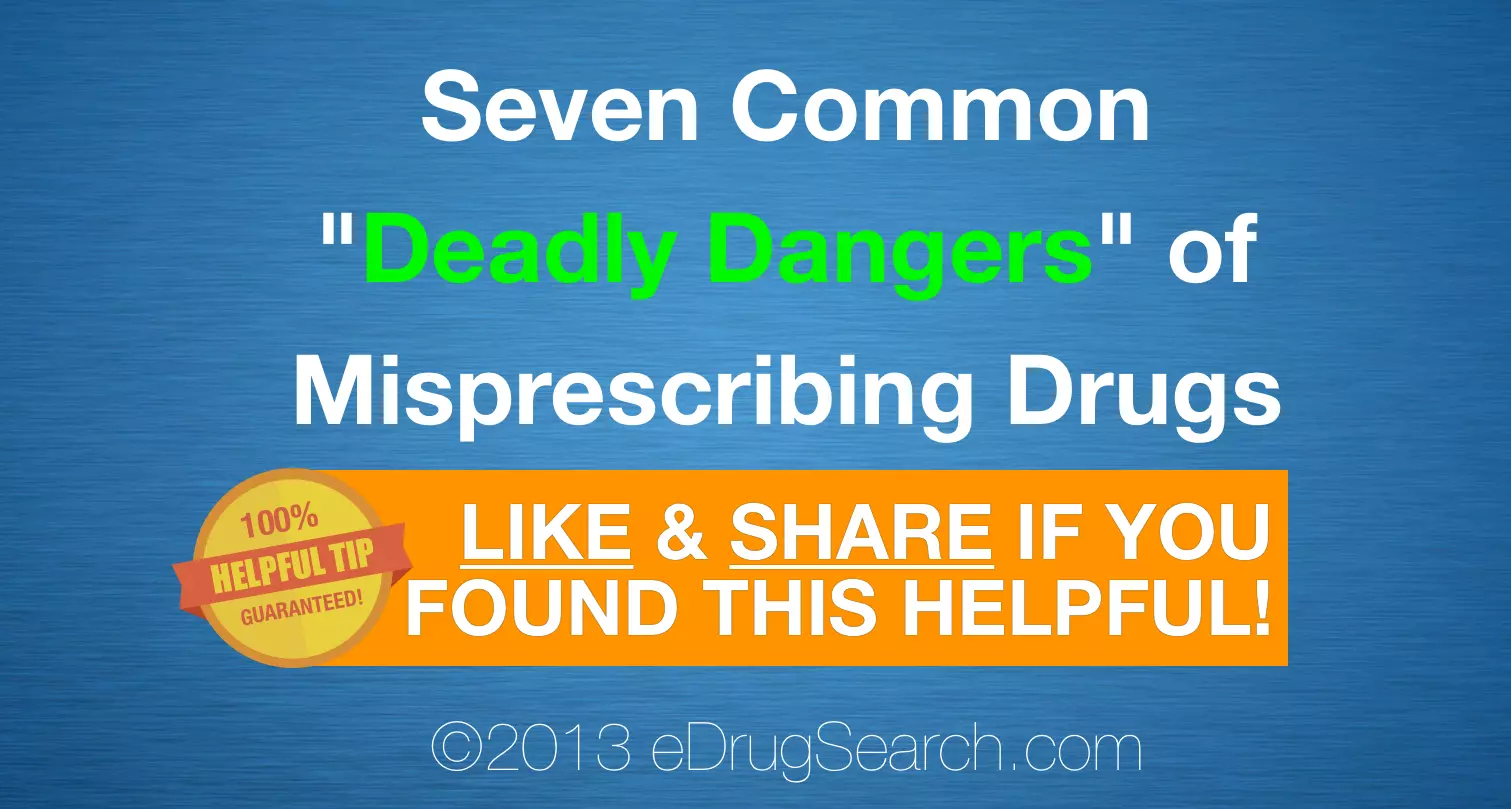Seven Common “Deadly Dangers” of Misprescribing Drugs

Every year, misprescribing drugs wastes tens of billions of dollars. These drugs are barely affordable to the people who must pay for their prescriptions out of their own pocket. However, the more serious consequence is that a minimum of 1.5 million people are hospitalized every year due to complications caused by medications that should never have been prescribed to them. Misprescribing drugs is also the cause of roughly 100,000 deaths every year.
The following is the seven most common “deadly dangers” of misprescribing prescription drugs:
- The original disease that a drug is prescribed for is really an adverse reaction to a different drug, masquerading as a disease. However, it is not recognized by the patient or the doctor. Instead of replacing the offending drug with a safer one or lowering the dose, the doctor adds an additional drug to help treat the adverse reaction caused by the original drug. Some examples of illnesses where misprescribing drugs in this manner is common include constipation, psychoes, insomnia, sexual dysfunction and depression.
- A problem that should first be treated using common sense lifestyle changes, is instead treated with a drug. Issues such as abdominal pain and insomnia regularly have causes that can be effectively treated without drugs. A careful history taken by the doctor can often discover these causes, avoiding the possibility of misprescribing drugs. Situational depression, anxiety, obesity, mild adult-onset diabetes and high blood pressure are other examples. The first approach a physician should recommend is a lifestyle change, instead of immediately writing a prescription.
- The medical problem is self-limited. It also does not respond to antibiotic treatments or does not need to be treated with certain drugs. This usually occurs with viral infections such as bronchitis or colds in adults or children that are otherwise healthy. Misprescribing drugs to healthy people happens more often that many people think.
- The medical problem would be best treated by a drug. However, instead of using the treatment that is cheapest, most effective and safest, the doctor prescribes an alternative that is less preferable. An example of this would be a doctor prescribing a drug to a patient that he or she is allergic to, but the doctor did not inquire about. Misprescribing drugs in this manner is frequently caused by not having proper records from a patient’s previous doctor. This is why a patient should make sure a doctor does a complete history when seeing a doctor for the first time.
- When used separately, two drugs may be perfectly safe. However, if they are taken together, misprescribing drugs in this case may result in serious illness or death.
- If two or more drugs are used for the treatment of an illness, one or more of the drugs may not be helping with the treatment. Misprescribing drugs may be causing an increased risk to the patient. Occasionally, these drugs can be combined into one pill. Other times, they will be separate pills. Mind-affecting drugs and heart drugs are often prescribed in this way.
- A prescription of the correct medication is given. However, misprescribing drugs has caused the dose to be too high. Older adults most often experience this problem. This is because they are not able to excrete or metabolize medication as fast as young people. Small people also have this problem when they are prescribed the same amount as a person weighing twice the amount that they do.
About this Angie’s List Expert: Cary Byrd is the president and founder of eDrugSearch.com. Based in San Antonio, eDrugSearch.com is a free cost comparison engine that helps consumers get safe access to affordable medications and advocates licensed online pharmacies as a widely accepted alternative.
Related Posts
- How to Protect Your Family from Drug Induced Injury
- Seniors on Prescription Drugs: How to Promote Safety and Effectiveness
- 2 Simple Steps on How to Read a Doctor’s Prescription Correctly
- How to Report Adverse Drug Reactions
- Money Saving Tips: How to Buy Prescription Drugs in Canada Safely
- Take a look at the pharmacy that fed Michael Jackson’s $48K per month drug habit







-
 Subscribe in a reader
Subscribe in a reader -
Ads

-
-
How to Safely Buy Prescription Drugs Online from Cary Byrd on Vimeo.
-
Medi-Share: Christian Health Insurance Alternative

-
Search Blog Posts
-
Blogroll
- Boerne Church
- Boerne website design
- Bullet Wisdom
- Bulverde Church
- Christian Social Network
- DrugWonks.com
- Eye on FDA
- Health 2.0
- Kevin, M.D.
- Pharm Aid
- Pharma Marketing
- PharmaGossip
- Pharmalot
- River Crossing Homes for Sale
- San Antonio Asphalt
- San Antonio Life Insurance
- San Antonio Pressure Washing
- The Health Care Blog
- The Peter Rost Blog
- Watch Christian Videos
- World Vision
-
Our Healthcare100 Ranking
-
Archives
-
Tags
adverse drug reactions Affordable Care Act big pharma Canadian drugs canadian pharmacies canadian pharmacy compare drug prices consumer reports Dave Ramsey discount drugs divine healing Drug costs Drug Importation Drug Prices eDrugSearch.com FDA Fosamax healing scriptures Health 2.0 health blog directory health blogs healthcare100 healthcare reform Hypertension Jehova Rophe Jesus Christ Lipitor Medi Share miracles Obamacare online pharmacy dictionary osteoporosis Pharmacies pharmacy spam Prescription drugs promote health blog Proverbs 3:5-8 reimportation relenza Roche saving money submit health blog Tamiflu The Great Physician The Lord our Healer
